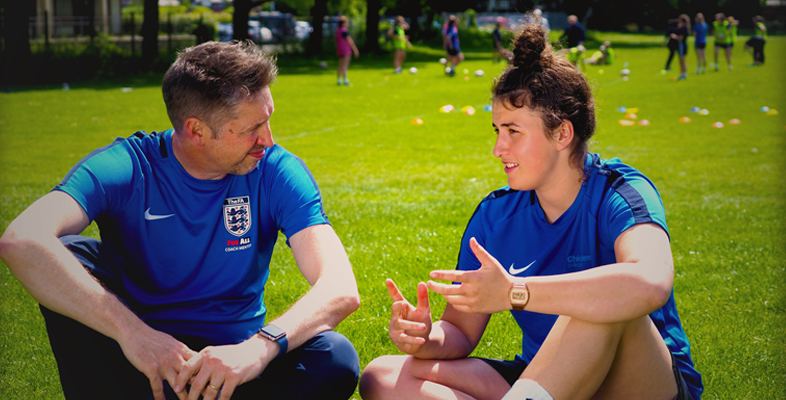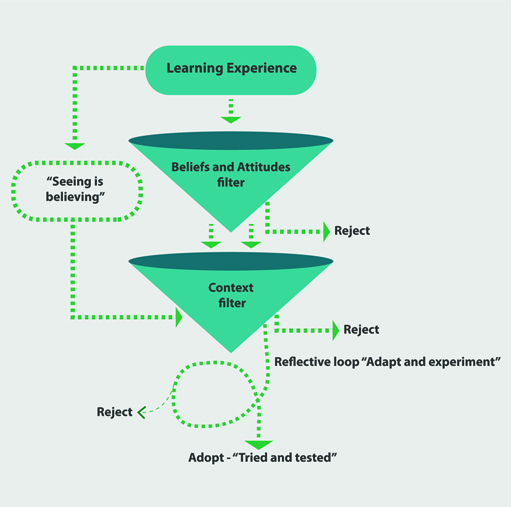4 Do coaches filter new ideas when they learn?
Research by Stodter and Cushion (2017) describes a filtering process through which coaches ‘adopted, adapted and rejected elements of their experiences, leading to uneven learning in apparently similar situations’ (p. 321).
If you begin to appreciate how coaches filter new ideas and knowledge, it could help you design learning experiences which are more likely to be effective.
Activity 4 Exploring Stodter and Cushion’s filtering processes
Read the description of Stodter and Cushion’s (2017) filtering processes below and examine its representation in Figure 6. After you have read the description you will be asked to answer two questions.
Filtering processes – a description
Coaches construct and develop their knowledge from learning experiences through two main filter mechanisms and a reflective feedback loop [see Figure 6]:
- A beliefs and attitudes filter: coaches first approach and understand learning experiences through the lens of their existing beliefs, attitudes, knowledge and coaching practice; this influences their perspective and acts as an initial filtering process. Ideas which mismatch their existing beliefs are filtered out and rejected, ideas that match or seem to fit are explored further.
- A context filter: coaches then ask themselves ‘how might this work in my context?’ and sometimes will avoid trying something due to a perception that it may not be relevant to their situation. Ideas that might seem appropriate pass through this filter and coaches experiment and adapt them and test whether they might work or not.
- Reflective cycle: coaches will continue to experiment, adapt and try-out ideas that have not yet been filtered out via a reflective feedback loop. This loop continues until they finally decide to adopt the idea into their practice or reject it. If an idea is accepted it can help to evolve their initial beliefs and attitudes filter.
Another influence was identified - ‘seeing is believing’ - in which new ideas were likely to bypass the first filter if coaches could see someone else using them (i.e. first hand, or via video). The openness of a coach to learning and their development, as well as the degree to which their working environment affords them the opportunity to experiment and adapt new ideas, are also important influences on the operation of the filtering mechanisms.
Now answer the following two questions:
- How do these processes and influences connect with coach learning and development?
- What does this framework suggest coach learning experiences should pay particular attention to in order for effective learning to take place?
Discussion
- When coaches see new ideas being used in a similar context to their own they are more likely to take an interest in them. This demonstrates how new ideas reinforced by favourable peer discussion might be adopted or adapted. In this way a coach’s practice repertoire may be influenced by their colleagues, yet a coach’s openness to change will also be shaped by any resistance from their colleagues and the culture of the environment they work in.
- Coach learning and development should pay attention to the two filters, a coach’s belief system and their coaching context, for new knowledge to be constructed. This means that ‘individualised, contextually and practically relevant learning opportunities are most valuable’ (Lyle and Cushion, 2017, p. 314). For this reason, having rich individual dialogue with coaches whereby you can start to surface their underlying beliefs gives you a chance to question assumptions and start to influence their belief systems (as discussed in Session 1).
The research by Stodter and Cushion highlights the complexity of learning and how specific it can be to each individual coach. Therefore without taking into account the context and individual needs of coaches, any homogeneous and generic learning programme is likely to have limited impact.
In the next section you’ll explore the principles associated with adult learning. These can be used to design more sophisticated learning environments which could potentially dilute some of the filtering processes used by coaches to assess new ideas.


